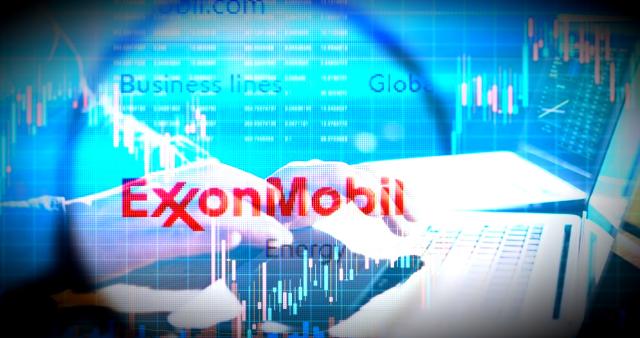
(Source: Shutterstock.com; Exxon Mobil image: Marko Aliaksandr / Shutterstock.com)
You might assume that Exxon Mobil Corp., being the largest public U.S. oil company and one that has paid a dividend for 37 straight years, would be mostly insulated from the oil price crash, but think again. The Institute for Energy Economics and Financial Analysis (IEEFA) is skeptical, saying the major’s efforts may fall short.
And in late March, Moody’s, which gives Exxon Mobil an AAA rating, cited rising debt concerns when putting the company on negative outlook. Despite turbulence in the bond markets, the company borrowed an additional $8.5 billion to support its capex and dividend strategies.
“Even before this year’s oil price dive, Exxon Mobil’s planned assets sales faced a challenging market,” according to the IEEFA’s recent report. “In 2019, the company anticipated $5 billion in proceeds from asset sales, but produced only $3.7 billion, well below target and about $1 billion below the company’s ten-year annual average.”
At its investor day conference in March, Exxon Mobil lowered its annual asset sales target from $5 billion to $3 billion per year through 2025. Yet, even that goal may be unrealistically high in today’s market, the group said.
“Exxon Mobil’s failure to meet its cash targets for asset sales, particularly at a time of low oil prices, contributes to the company’s poor cash flow. This is a significant contributing factor to Exxon’s deteriorating stock performance,” said IEEFA financial analyst Kathy Hipple, lead author of the note.
Exxon Mobil isn’t alone in its divestment plans, but the risk is that any sales, f they occur at all, may garner substantially less than anticipated, the report said. “Further, in the current environment where many companies are reducing capital expenditures, less money will be available for acquisitions. With weak, or potentially no, asset sale proceeds, Exxon Mobil will increasingly be forced to borrow to cover its dividend payments and capital expansion plans,” Hipple said.
Over the past decade, the company’s free cash flow has only covered two-thirds of the dividend. “Just last year, Exxon Mobil paid $15.3 billion to shareholders, while generating only $5.4 billion in free cash flows—leaving a $9.9 billion deficit that the company made up from other cash sources, including $5.4 billion in new long-term borrowing and $3.7 billion in asset sales.”
Credit analysts increasingly cite Exxon Mobil’s cash flow challenges as an area of concern.
In early April, Exxon Mobil said it would now plan to slash capital spending by 30%, pulling back on its multiyear investment in shale, LNG and deepwater oil production due to destruction on demand by the coronavirus pandemic. Additionally, the company also raised $9.5 billion in new debt, according to a regulatory filing.
Recommended Reading
Iraq to Seek Bids for Oil, Gas Contracts April 27
2024-04-18 - Iraq will auction 30 new oil and gas projects in two licensing rounds distributed across the country.
US Raises Crude Production Growth Forecast for 2024
2024-03-12 - U.S. crude oil production will rise by 260,000 bbl/d to 13.19 MMbbl/d this year, the EIA said in its Short-Term Energy Outlook.
NAPE: Turning Orphan Wells From a Hot Mess Into a Hot Opportunity
2024-02-09 - Certain orphaned wells across the U.S. could be plugged to earn carbon credits.
Exxon Versus Chevron: The Fight for Hess’ 30% Guyana Interest
2024-03-04 - Chevron's plan to buy Hess Corp. and assume a 30% foothold in Guyana has been complicated by Exxon Mobil and CNOOC's claims that they have the right of first refusal for the interest.
Petrobras to Step Up Exploration with $7.5B in Capex, CEO Says
2024-03-26 - Petrobras CEO Jean Paul Prates said the company is considering exploration opportunities from the Equatorial margin of South America to West Africa.



